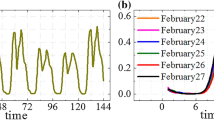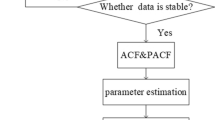Abstract
For mobile communication traffic series, an accurate multistep prediction result plays an important role in network management, capacity planning, traffic congestion control, channel equalization, etc. A novel time series forecasting based on echo state networks and multiplicative seasonal ARIMA model are proposed for this multiperiodic, nonstationary, mobile communication traffic series. Motivated by the fact that the real traffic series exhibits periodicities at the cycle of 6, 12, and 24 h, as well as 1 week, we isolate most of mentioned above features for each cell and integrate all the wavelet multiresolution sublayers into two parts for consideration of alleviating the accumulated error. On seasonal characters, multiplicative seasonal ARIMA model is to predict the seasonal part, and echo state networks are to deal with the smooth part because of its prominent approximation capabilities and convenience. Experimental results on real traffic dataset show that proposed method performs well on the prediction accuracy.







Similar content being viewed by others
References
Khashei M, Bijari M (2011) A novel hybridization of artificial neural networks and ARIMA models for time series forecasting. Appl Soft Comput 11(2):2664–2675
Sun HL, Jin YH (2009) Network traffic prediction by a wavelet-based combined model. Chin Phys B 18(11):4760–4768
Xie YC, Zhang YL, Ye ZR (2007) Short-term traffic volume forecasting using Kalman filter with discrete wavelet decomposition. Comput Aided Civil Infrastruct Eng 22(5):326–334
Guo K, Zhang X (2008) Application of EMD method to friction signal processing. Mech Syst Signal Process 22:248–259
Goh G, Law R (2002) Modeling and forecasting tourism demand for arrivals with stochastic nonstationary seasonality and intervention. Tour Manag 23(5):499–510
Tay F, Cao L (2001) Application of support vector machines in financial time series forecasting. Int J Manag Sci 29(4):309–317
Jiang XM, Adeli H (2005) Dynamic wavelet neural network model for traffic flow forecasting. J Transp Eng ASCE 131(10):771–779
Schrauwen B, Verstraeten D, Campenhout JV (2007) An overview of reservoir computing: theory, applications and implementations. European Symposium on Artificial Neural Networks 2007, pp 471–482
Jaeger H, Haas H (2004) Harnessing nonlinearity: predicting chaotic system and saving energy in wireless communication. Science 304:78–80
Mallat SG (1989) A theory of multiresolution signal decomposition: the wavelet representation. IEEE Trans Pattern Machine Intell 11(7):674–693
Daubechies I (1990) The wavelet transformation, time-frequency localization and signal analysis. IEEE Trans Inf Theory 36:961–1005
Rocha Reis AJ, Alves da Silva AP (2005) Feature extraction via multiresolution analysis for short-term load forecasting. IEEE Trans Power Syst 20(1):189–198
Nobre FF, Monteiro ABS (2001) Dynamic linear model and SARIMA: a comparison of their forecasting performance in epidemiology. Stat Med 20(20):3051–3069
Papagiannaki K (2005) Long-term forecasting of internet backbone traffic. IEEE Trans Neural Netw 16(5):1110–1124
Percival DB, Walden AT (2000) Wavelet methods for time series analysis. Cambridge University Press, Cambridge, pp 159–205
Pindoriya NM, Singh SN, Singh SK (2008) An adaptive wavelet neural network-based energy price forecasting in electricity Markets. IEEE Trans Power Syst 23(3):1423–1432
Author information
Authors and Affiliations
Corresponding author
Additional information
Yu Peng and Miao Lei contributed equally to this research.
Rights and permissions
About this article
Cite this article
Peng, Y., Lei, M., Li, JB. et al. A novel hybridization of echo state networks and multiplicative seasonal ARIMA model for mobile communication traffic series forecasting. Neural Comput & Applic 24, 883–890 (2014). https://doi.org/10.1007/s00521-012-1291-9
Received:
Accepted:
Published:
Issue Date:
DOI: https://doi.org/10.1007/s00521-012-1291-9




